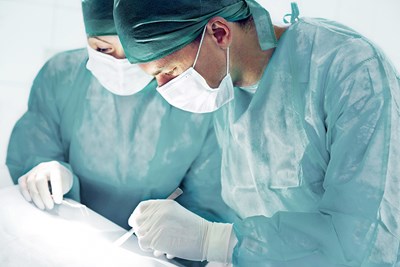While laparoscopic surgery, treatment, and diagnostics have been a boon to many areas of medicine, they have been particularly useful for women’s health. Open surgeries have been made less traumatic, many things that would require more invasive methods for diagnosing have become outpatient procedures, and even problems with fertility can be discovered and managed through obstetric and gynecological laparoscopy. Rather than open surgery, in which the abdomen receives a large incision, an incision about a half inch long is made. A long, slender tube with a light and camera (laparoscope) is then inserted, so that what’s going on inside can be seen on a monitor.
Endometriosis
Although men have their own set of reproductive organs that can benefit from laparoscopic procedures, the things that go wrong with women can be a bit more intrusive to investigate, since they are almost solely internal. According to the American College of Obstetrics and Gynecology, there are several women’s health issues that can be dealt with laparoscopically.
Endometriosis, a condition in which the lining of the uterus begins to grow outside of it, can cause chronic abdominal pain and exceptionally difficult periods. When other methods fail to be effective, the use of a laparoscope allows doctors to get an internal view with very little scarring, and the overgrown tissue can often be removed at the same time.
Growths and Cancers
Fibroids, small growths or cysts on the uterus, and ovarian cysts can be painful and cause excessive bleeding. Although not all are malignant, some of these growths can be cancerous. These too can be diagnosed and removed laparoscopically. In fact, there are a variety of cancers specific to women that can be managed using laparoscopic procedures.
Pregnancy and Fertility
Sometimes when an egg is fertilized, rather than moving to the uterus, it remains in a fallopian tube. This can be extremely dangerous for a women. Laparoscopic removal provides relief from a difficult issue with faster recovery time. Conversely, women who are having difficulty achieving a desired pregnancy who have exhausted other options may find that laparoscopic assessment may show answers that other imaging or blood tests do not provide.
Surgical Procedures
Additionally, many women have pelvic floor disorders following pregnancy or menopause. The bladder, uterus, rectum, vaginal walls, and other organs sometimes lose strength or elasticity and fall from their proper place. Vaginal mesh implants were common, but led to many difficulties and lawsuits from complications. New laparoscopic procedures allow for these organs to be restrengthened, relieving pain and pressure on the pelvic floor which can cause urinary incontinence.
Hysterectomies, the removal of the uterus, and oopherectomies, the removal of the ovaries, can be done laparoscopically, speeding recovery time and reducing scarring. The organs are removed in small pieces through the shorter incisions laparoscopic procedures require.
Tubal ligation, commonly referred to as “having one’s tubes tied,” or female sterilization can also be done laparoscopically. Although there are many benefits to having these procedures performed this way, it is important to talk to your doctor about the best option for you, as laparoscopic procedures come with their own risks as well.



